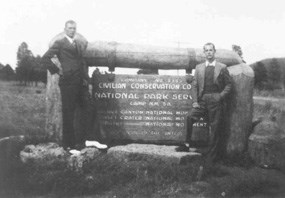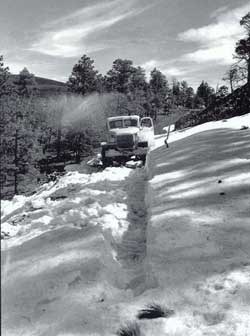
"If they asked me to go, I'd go tomorrow," said Albert Spudy, reminiscing about his days in the Civilian Conservation Corps. Spudy and other men spent part of their youth working at Sunset Crater, Wupatki, and Walnut Canyon as Civilian Conservation Corps (CCC) recruits. They left their mark on these monuments - in the steps that wind their way to the Island Trail in Walnut Canyon, in the first visitor center that blended impeccably with its surroundings, in the ranger residence at Wupatki that looks as if it belongs to the landscape. Spudy and two hundred other men were members of the Mount Elden CCC Camp located in Flagstaff. They were part of a national effort to, among other things, assist the National Park Service in the development and improvement of roads, trails, and facilities. The CCC provided a work force to implement the National Park Service's Master Plan. In order to preserve the natural character of a landscape, roads, trails and buildings were designed to blend with the natural setting. Construction materials were quarried on-site. Native materials were used to blend the new with the old. The built environment envisioned by National Park Service landscape architects and implemented by the CCC shaped the visitor experience throughout the park system and still does today. Large parks and small monuments from Grand Canyon, Yosemite and Yellowstone to Sunset Crater, Walnut Canyon and Wupatki all benefited from this great legacy. 
Two million men worked as CCC recruits in more than 1,200 camps across the country between 1933 and 1942. Initially known as the Emergency Conservation Work program, the CCC was created by President Franklin D. Roosevelt to provide impoverished youth of the Depression the opportunity to improve their education and ability to earn a living. It also realized Roosevelt's desire to conserve the human and natural resources of the nation. Roosevelt's hopes to assist the unemployed are echoed in the words of Albert Spudy, "Why did I go? I loved the work, and I thought I could make something better out of myself by going to the three Cs." Nationwide, the CCC accomplished wonders: enrollees built 63,256 buildings, 3,116 lookout towers and 28,087 miles of trails; erected 405,037 signs, markers, and monuments; planted 45 million trees; and fought countless fires. They developed more than 800 state parks. Thousands learned trades that lasted a lifetime. In addition, the CCC provided long-lasting friendships and a sense of loyalty and pride. It seems Roosevelt's program was a success. The United States entry into World War II foreshadowed the end of the Civilian Conservation Corps. Congress terminated the program on July 2, 1942. The CCC legacy, however, lives on in the nation's landscape and in the hearts of its members and their descendants. There are CCC alumni chapters throughout the country, and efforts continue to preserve the physical evidence of the program. The Flagstaff Area National Monuments and 11 other parks in the southwest have been awarded a Save America's Treasures Grant to conserve CCC items, including furniture, light fixtures, signs, photographs, and personal items.
|
Last updated: March 11, 2024
